Join the tribe of Movement & Calisthenics Athletes – people just like you that are working with their own body weight to get strength, lose fat build muscle, recover from injuries and live their best lives!
👋Hello everyone! I am Dr.Dhairya(The+E+Rya) here chief physical therapist & founder of Fitnat. If you can’t pronounce my name just call me Dr.Deprogrammer. I have been using Calisthenics to treat all my patients from teenage to geriatric age!
I am gonna share with you how and why I provide my treatment without any equipment/tools/machines/passive modality.
As i was myself inspired by Calisthenics so i thought why can’t i just practice it into my treatments and it worked really well.
So when a person visits me and after hearing my introduction, the usually response I get is:
😲 “WOAH ! YOU DON’T USE ANY EQUIPMENT?
WHAT IS CALISTHENICS?”
Calisthenics is a NATURAL MOVEMENT!
Natural means – things with which we are born with, or things we got when we were born. Natural Movements mean the same thing- movements with which we are born with.
NO ONE taught us Natural movements like Rolling, Crawling, Lunging, Getting up, Walking, Jumping, Running etc. Think as if natural movements are a software inside us which developed on its own time with our development.
When I make them move naturally, their PRIMAL brain works on their own as NATURAL is often an innate software present within us. So the nervous system enhances the process of self-healing and thus I use Calisthenics to:
- Improve Dysfunctions
- Treat Pain
- Prevent Injuries.
🤔 “What’s the difference between pain, Injury
and dysfunction? Ain’t they all the same?”
Here’s a simple diagram of an ICEBERG.
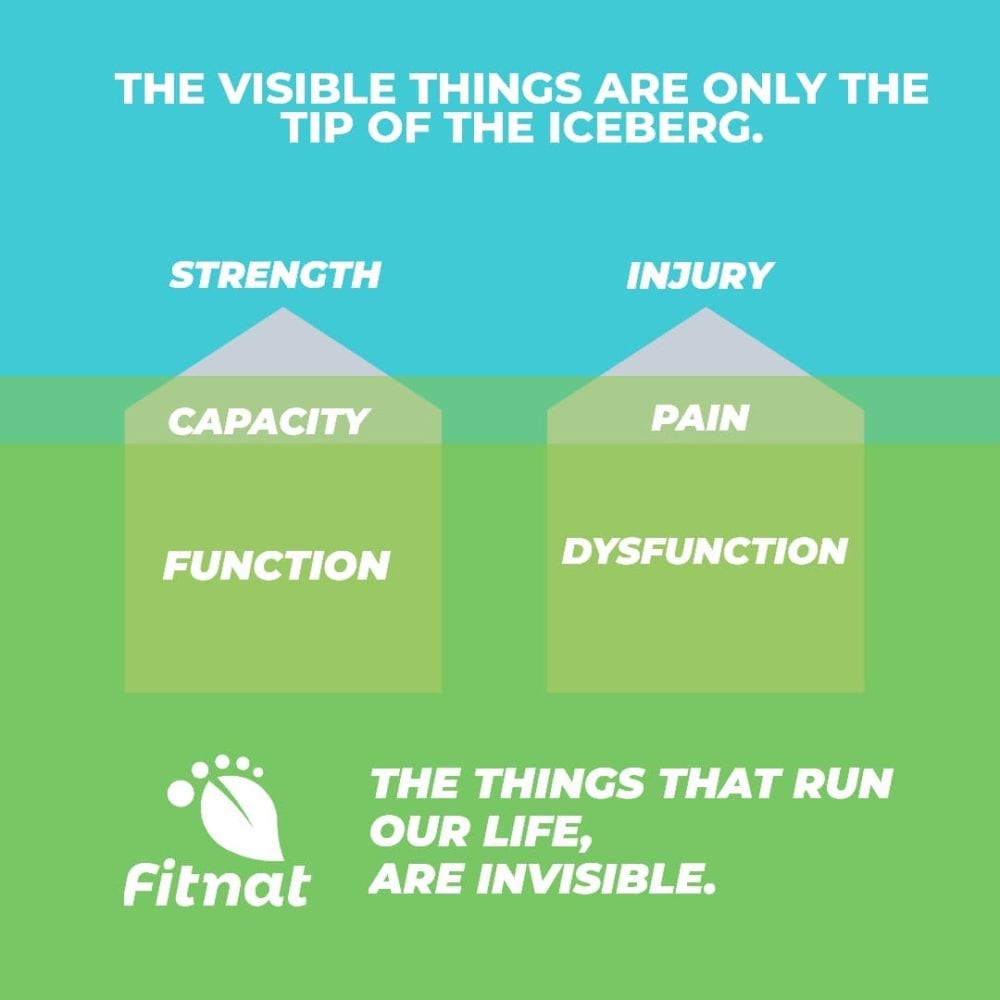
You can see in the image that pain and injuries are just the tip of the iceberg. Underlying major part is the “Dysfunction”.
Now there are many complicated meanings of these terms but let’s keep it simple:
👉WHAT IS DYSFUNCTION?
“Dysfunction means when a part/group of things in your body is not acting naturally or is diverted from its natural function” – thus the term Dys+function (disturbed function).
For example: The job of the muscles in the wall of the digestive tract is to make sure the food goes DOWNside when you eat & not come UPside. This means the muscles in the tract are functional. But if they don’t play their job – the food comes out & we can say that this is called a dysfunction(disturbed function).
👉INJURY IN SIMPLE TERMS…
“Injury is a damage(physical/mental) to the human body (internal/external). It can be divided into 2 types – contact injury (external damage eg. Fall, punch, slip, accident etc) or non-contact injury (internal damage like dislocation, muscle tear, tendon rupture etc).
Basically Injury happens when our body/body part witnesses the force greater than its capacity.
👉WHAT IS PAIN?
So whenever the Brain/Nervous system feels that dysfunction is growing – it gives us UNPLEASANT SIGNALS which are termed as PAIN. Pain is just a signal from the body when our brain ASSUMES the presence of dysfunction.
Pain is NOT the dysfunction.
Pain is also the last thing you feel.
So when the dysfunction is begun in a part/system of body – the body gives the signals like:
- 🙁 Tightness/stiffness in a movement,
- 🙁 Decrease in balance,
- 🙁 Improper coordination,
- 🙁 Inability to breathe good in a position,
- 🙁 Cramps in a movement
- 🙁 Numbness etc…
Pain is the last thing your body gives you as a signal when the dysfunction is growing and your brain calculates that dysfunction will lead you to an Injury.
So “Pain is also a request from your body for a CHANGE.”
THE MISTAKE PEOPLE MAKE IN ORDER TO TREAT THE PAIN!
We need a huge load of awareness & correct education when it comes for the topic of pain & injuries. This is the reason why we start our treatment with patient education! We try to bring a positive flow of thoughts & try to change their words.
Most common thoughts that people think when they experience the pain are:
- 👎 Pain is a bad thing.
- 👎 I need to kill the pain.
- 👎 My treatment is done when my pain is gone.
- 👎 I gotta take pain relief drugs as much as possible. etc
SO PEOPLE THINK THAT PAIN IS THEIR ENEMY- & they opt for passive treatment such as !
[ Passive treatment means a person is lying & doing NOTHING. All the work is done by machine or the therapist. ]
- 📌 Electrotherapy – the use of electric currents to desensitize the pain signals. This is a sure way to relieve the pain but NEVER treats your dysfunction.
- 📌 TheraGun – another way to desensitize pain signals by the use of percussion. It is an excellent way to promote recovery but a surest way to forget & work on the dysfunction.
- 📌 Trigger Point Therapy – an excellent way to relieve the body from tightness, knots & stiffness. But these are just the symptoms of the body. The body develops the trigger points when there is a stability issue in the body. We need to find the stability issue before treating the symptoms with trigger point therapy.
- 📌 Posture correction belts & straps – they do correct the posture but what about the strength of muscles that are responsible for it? They get even weaker! Weak muscles definitely don’t help to correct the dysfunction. So in the long game – posture correction straps & belt don’t help you.
- 📌 Surgery – A surgery is an option but we should always try to correct the dysfunction with Active Movement Treatment. Issues like – Scoliosis, Osteoarthritis of knee, Disc Bulging, Tunnel syndromes of wrist & ankle, Spondylitis etc can easily be treated without surgeries. Not only surgery causes you even more damage but movement treatment makes you healthy, strong & happy for the long term.
🔎These things DO REDUCE THE PAIN – no doubt in that. But these things DO NOT CORRECT the Dysfunction & definitely DON’T TREAT the injuries.
ACTIVE TREATMENT REWARDS YOU MORE THAN JUST PAIN REDUCTION.
The correct mindset is to understand the reason behind pain along with dysfunction.
The brain responds with pain when dysfunction is increasing.
When the dysfunction is improving the brain responds by reducing the pain as well.
It also make you feel better in other ways like:
- Making you feel stronger & confident in a movement.
- Making you resistant to previous dysfunction, so likelihood of the same type of injury is LESSER.
- Making you Move better than before etc
When you experience the above things we can safely say that you have been treated from the injury !
WHY CALISTHENICS IS A GREAT SOLUTION FOR TREATING PAIN? 💯
Upon understanding the above differences and being now aware that by treating the dysfunction we can prevent & treat the injuries, the topic we need to tackle is why choose calisthenics instead of other forms of rehab?
I’ll begin to note my favourite things about calisthenics.
1. 😊 Calisthenics teach your body to move functionally – as it was meant to move.
Calisthenics movements are natural as i stated earlier. They are not artificial like a machine in the gym. So by practicing regular calisthenics you not only maintain the healthy functional capacity of the joints but also increase their strength in a progressive nature.
- Due to this functional nature of calisthenics, it is therefore my prefered way to fight the dysfunctions in my patients.
2. 😊 Calisthenics has a lot of variables – so can be modified to suit any person.
Best thing about calisthenics are the variables. I can teach one exercise in many ways to any one depending on their capacity, age or even injury factors.
For eg: if i want to teach pushing movements to improve the ability of the body to push things – i can teach it to children in a form of crawling, athlete in a form of pushups & elders in a form of statics like pushing the wall. So ONE calisthenics movement ie Pushing is modified in different ways to teach to MORE THAN ONE people with different capacity, strength & abilities.
3. 😊 Calisthenics has a LOT of progressions.
I can increase/decrease the level of difficulty very very easily. Calisthenics is all about leveraging gravity and playing with weight distribution. I can make an exercise harder by changing the weight distribution. For eg. If I want my patient to bend the knees, I can start by teaching that lying on the ground at first e.g. lying bent knee raises.. Then I can make it difficult by adding more gravity factor – so I can teach him bending knees with crawling movement. If i want to add even more gravity to make it harder then i can add squats.
In all the above movements – the patient is being taught one thing – bending the knees under different factors! So calisthenics is highly adjustable to one’s level of strength and pace of recovery.
4. 😊 All the rehab principles can be accomodated & applied via calisthenics.
👉 Calisthenics is not only adjustable & progressive but the rehab principles can be accommodated with calisthenics really easily. For eg:
- ✅ Principle of joint distraction: I can distract any joint with calisthenics to increase the joint healing & fluid circulation. Eg If someone has a spinal decompression i can teach him hanging knee raises/pull ups. They involve not only decompression of spine but improving stability of spine by working on Core & Latissimus respectively as an added benefit!
- ✅ Principle of proprioception: In many neruro-muscular disorders the patient loses the ability to sense the joint position. I can easily teach this with calisthenics!
- ✅ Principle of sensory input: Sensory input is ability to feel the things which are in contact with our body. MIND TO MUSCLE connection is one such thing. This can be very easily taught with calisthenics to improve the ability of sensing a particular part in a particular movement to improve the function. Eg: If the chest muscles are poorly functioning in a pushing movement – I can teach them a good old wide pushup. If shoulders are not acting stable in a pushing movement – I can teach slow-tempo normal width pushups etc.
5. 😊 Calisthenics is FUN.
Hands down calisthenics is the most interesting movement training system. One can play with calisthenics in many different ways. I like to keep my rehab NON-BORING. So I usually incorporate a lot of games in my rehab & calisthenics helps me to achieve this goal.
LET’S SEE FEW CASE STUDIES
🩺(Pain x Dysfunction)
👨🏫 CASE 1. SHOULDER PAIN FEATURING SCOLIOSIS
Brief:
The athlete had developed the shoulder pain on the LEFT side. The pain was developed gradually within 6 months. The athlete is into advanced calisthenics since 4 years.
Assessment:
The examination of the shoulder joint was surprisingly found perfectly normal – despite being the site of pain. So we examined the spine & found Scoliosis – an abnormal curve in the spine. Despite the presence of Dysfunction in the spine, there was No Pain!
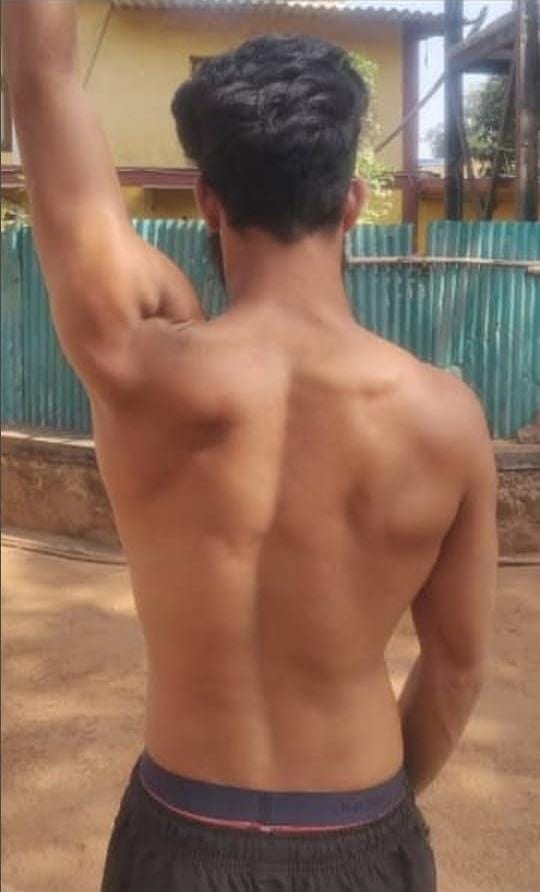
Treatment:
As the dysfunction was present in the spine – we needed to work on it!
As the athlete was into advanced calisthenics we used his favourite & strong movement to work on the dysfunction. One of the major movement we used to treat him was ONE ARM Handstand on the Right side.
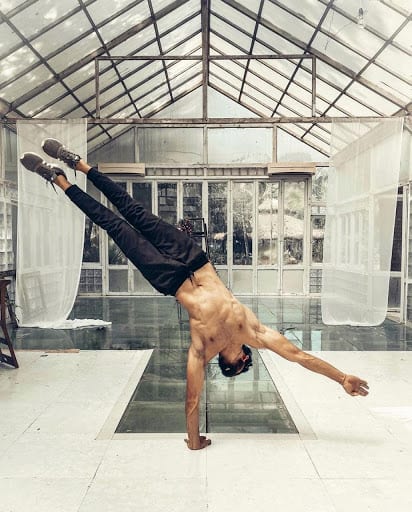
Result:
As you can clearly see the dysfunction in the spine was resolved in the following image:
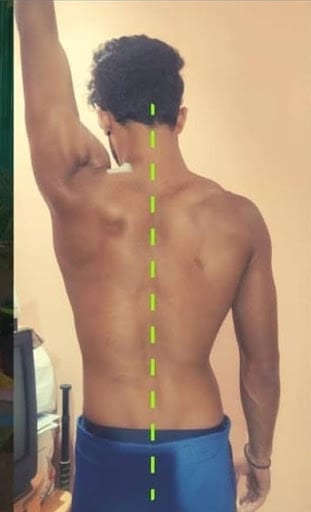
The athlete was completely pain free in the shoulders WITHOUT – any X-rays, Pain pills, or any passive modalities! We just worked with consistent & progressive Strength!
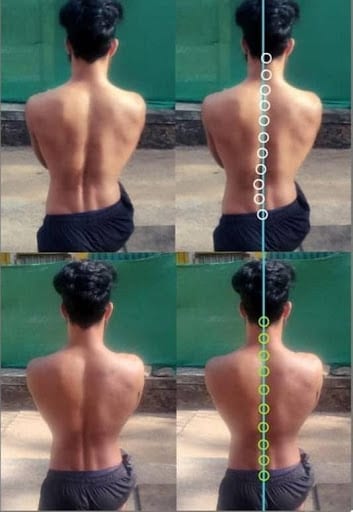
👨🏫 CASE 2. LOWER BACK PAIN FEATURING SQUATS
Brief:
The athlete is 21 y/o & has developed moderate lower back pain since 3 months. He is a beginner in calisthenics – & experiences pain when he practices squats.
The athlete is also a student who sit to study for at minimum 9 hours/day
Assessment:
The examination
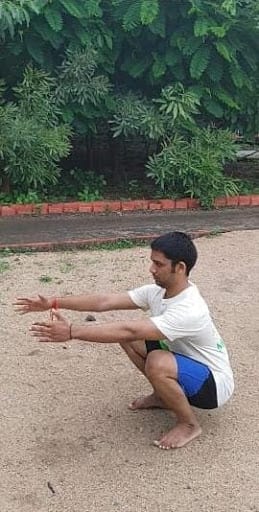
As we can see in the image – the athlete is sitting in the bottom of the squat position.
We all can notice 2 things.
- He’s having a pretty decent Range of motion of Hip, Knee & Ankle joint in the bottom of squat. This indicates that he has a good & flexible lower body!
- We can also see the spine is tall & good.
Examination:
As we can see that the mechanics of squat were pretty decent, we thought that – “ maybe he spent most of the time sitting & studying – which may have led to compressive forces on the spine when he sat in the bottom of squat.
Treatment:
So we decided to work on the decompression of the spine. And for this purpose we made him practice this movement – ( Insert image 6 ) – Hanging knee raises!
If we compare the Hanging Knee Raise & Squat – we can see that the position of joints in both the movements is almost SIMILAR.
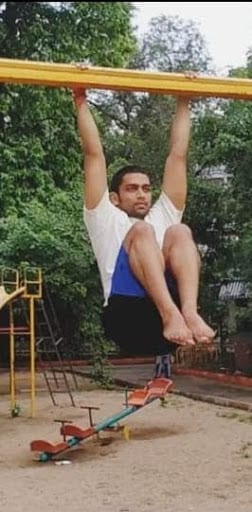
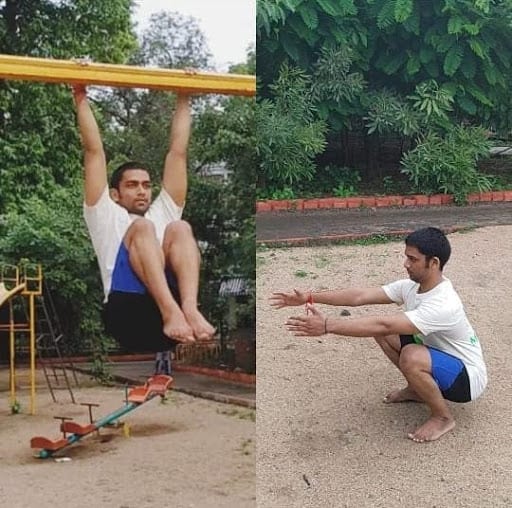
And here are the advantages: The spine is being DECOMPRESSED due to hanging & the core is gaining stability with hanging knee raises. The proprioceptors in the joints only recognize that the movement of joints is being done – but they don’t know that different muscles are acting for it. So as an end result – brain things that body’s squatting pain free.
Result:
After practicing hanging knee raises daily, the person not only felt pain free with squat but felt a great improvement in overall strength, stability & capacity. Also the pain was a signal from the body that his spine needed decompression due to prolonged sitting – so we also brought a lifestyle change in his work life.
NOTE THAT – If he treated his back pain with pain killer gel or pill, he would have resulted in disc problems. Eventually, as the pain dissipates with the pain killers, the dysfunction in his work life would still be present. So by treating the “MOVEMENT DYSFUNCTION”, he did a wise job!
👨🏫 CASE 3. CHEST PAIN FEATURING OVERHEAD SHOULDER PRESS
Brief:
The person noticed a chest pain of mild intensity when we did overhead press in the gym.
The person’s occupation is a desk job work – & he joined the gym after being sedentary for one year. He noticed the pain after a few days of joining the gym.
Assessment:
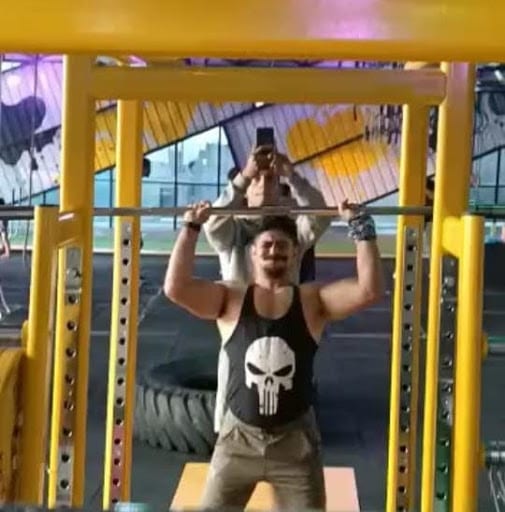
Notice ONE important thing in this photo when the person is doing the overhead barbell press.
- Notice the face: He can barely breathe even if he lifts just the barbell. This is a very important sign.
- When a person is not able to breathe in a certain position- this means that person is not able to stabilize the core. Ask a weightlifter – What would happen when the core is not stabilized? – You know the answer is INJURY!
- So when the core is not stabilized the person tends to breath shallow in the chest which explains the overworking/strain in the Pec muscles.
Treatment:
We selected a perfect exercise for him – “ECCENTRIC TRUNK EXTENSION” (aka Controlled Back Bending)
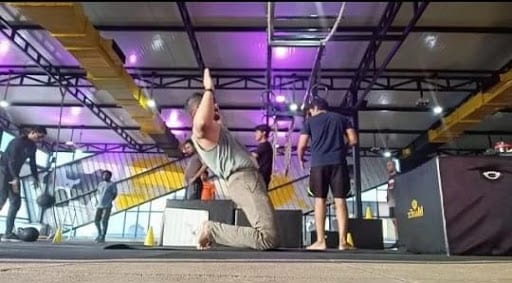
👆 Thing is, we NEED to examine the whole body.
Its like solving a murder mistery where we have to consider – almost everyone who are connected with the victim. Guess what, your body is One single structure with everything connected to each other inside it. So we can’t really treat the pain by ONLY working on the site of pain.
So friends, I hope that you all are very versed in calisthenics but might never have thought that it can be used to provide rehab.
Believe me when I say that I have prevented complex surgeries and costly treatments of cases of Ligament tears, Scoliosis, Osteo-arthritis, Fibromyalgia etc with pure calisthenics.
So if you like the above read and want to dive deep into my world – let us know in the comments below.
I have the ability to simplify complex things & with my experience of working in this field, I will make sure to provide you value in the simplest, applicable & actionable ways possible. Thank you.